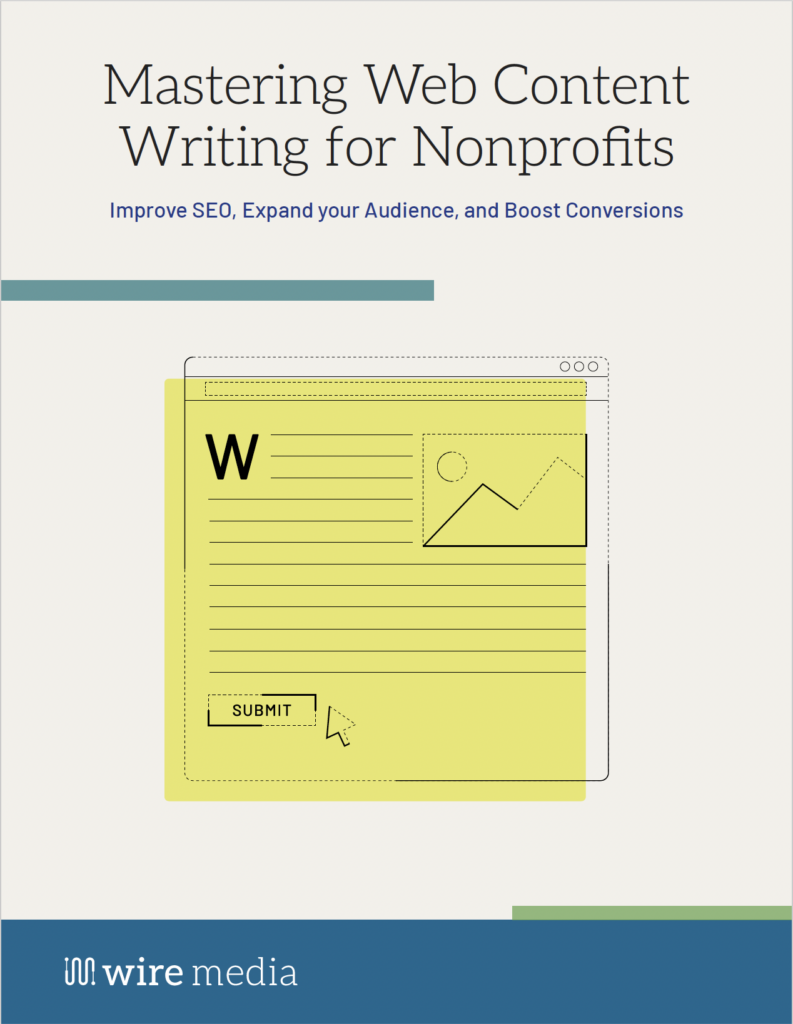
Today, we want to dive into a super important topic: web accessibility in the age of artificial intelligence (AI). We all know how crucial it is to ensure everyone can access and enjoy the internet – especially the amazing work happening in nonprofit spaces like yours. But how does AI fit into this? AI, while convenient, has its challenges. Let’s explore the up(and down)sides of using AI to create web content.

Transform nonprofit copy into easy-to-read web content with this guide.
Get the PDFNothing is perfect…not even AI
In the spirit of always wanting to end with good news, let’s start with a few challenges when it comes to AI:
Bias in AI Algorithms: One of the biggest challenges with AI is that it can be, well, biased. This happens because AI learns from data. If the data it’s trained on is biased, the AI tool will be too. For example, if an AI tool is trained mostly on images of people with lighter skin, it might not recognize people with darker skin. This can be a problem when creating content that’s supposed to be inclusive. If AI tools fail to recognize or properly represent diverse audiences, the content created won’t be as accessible as it should be.
Complexity of Human Language: Human language is incredibly complex and full of nuances, slang, and idioms. AI still struggles to understand and use language as naturally as people do. AI-generated content can sometimes be awkward or hard to understand, especially for people with cognitive disabilities or non-native speakers. Ensuring that AI-generated content is clear and easy to understand for everyone is a significant hurdle.
Over-Reliance on Automation: Another challenge is the temptation to rely too heavily on AI for creating and managing content. While AI can do a lot, it can’t do what a person can do…yet. Nonprofit organizations might use AI to automate content creation to save time and resources, but it still requires human oversight to ensure the content meets accessibility standards. Over-reliance on AI can lead to a lack of personalization and empathy that human-generated content naturally provides.
What AI Does Well
There may be some challenges when using AI. But let’s not throw the baby out with the bathwater. Here are a few ways AI can enhance your nonprofit’s efforts:
Enhanced Assistive Technologies: AI has the power to significantly improve assistive technologies. For instance, AI-powered screen readers can better interpret and describe web content to visually impaired users. Tools like voice assistants (think Siri or Alexa) use AI to help people navigate the web using voice commands. These advancements can make the internet more accessible to people with disabilities, giving them greater independence and access to information.
Automated Content Customization: AI can help create content that is tailored to individual needs. For example, AI can adjust the reading level of content based on a person’s preferences or needs, making it easier for people with different literacy levels to understand. It can also provide real-time translations, making content accessible to people who speak different languages. This kind of customization ensures that more people can access and benefit from web content.
Enhanced User Experience: AI can analyze how users interact with a website and suggest improvements to make the experience more user-friendly. For example, AI can identify parts of a website that are difficult to navigate for users with disabilities and suggest changes to make it more accessible. This can include things like adjusting font sizes, changing color contrasts, or reorganizing the layout for better readability. By continuously learning and adapting, AI can help create a more inclusive web experience for everyone.
Bringing It All Together
While AI brings a mix of challenges and opportunities for web accessibility, the key is finding a balance. Nonprofits can benefit greatly from AI, but it’s essential to remain aware of its limitations. Here are a few tips to help you make the most of AI while ensuring your content is accessible to all:
- Complete regular audits. Conduct regular accessibility audits on your content. Use both AI tools and human reviewers to ensure that your content meets accessibility standards and is free from bias.
- Train your teams…and retrain them as new tools are released. Keep your team informed about the potential biases in AI and the importance of inclusive content. Provide training on how to use AI tools effectively while maintaining a human touch.
- Seek feedback from your site visitors. Encourage feedback from your audience, especially those with disabilities. This will help you understand their needs better and improve your content accordingly.
- Collaborate with experts. Work with accessibility experts and people with disabilities to ensure that your AI tools and content are genuinely inclusive and effective.
AI is an incredible tool that can help make the web more accessible, but it’s not a magic wand. By combining the power of AI with human empathy and insight, we can create a web that’s truly for everyone. Embrace the possibilities of AI while staying committed to inclusivity and accessibility for everyone.